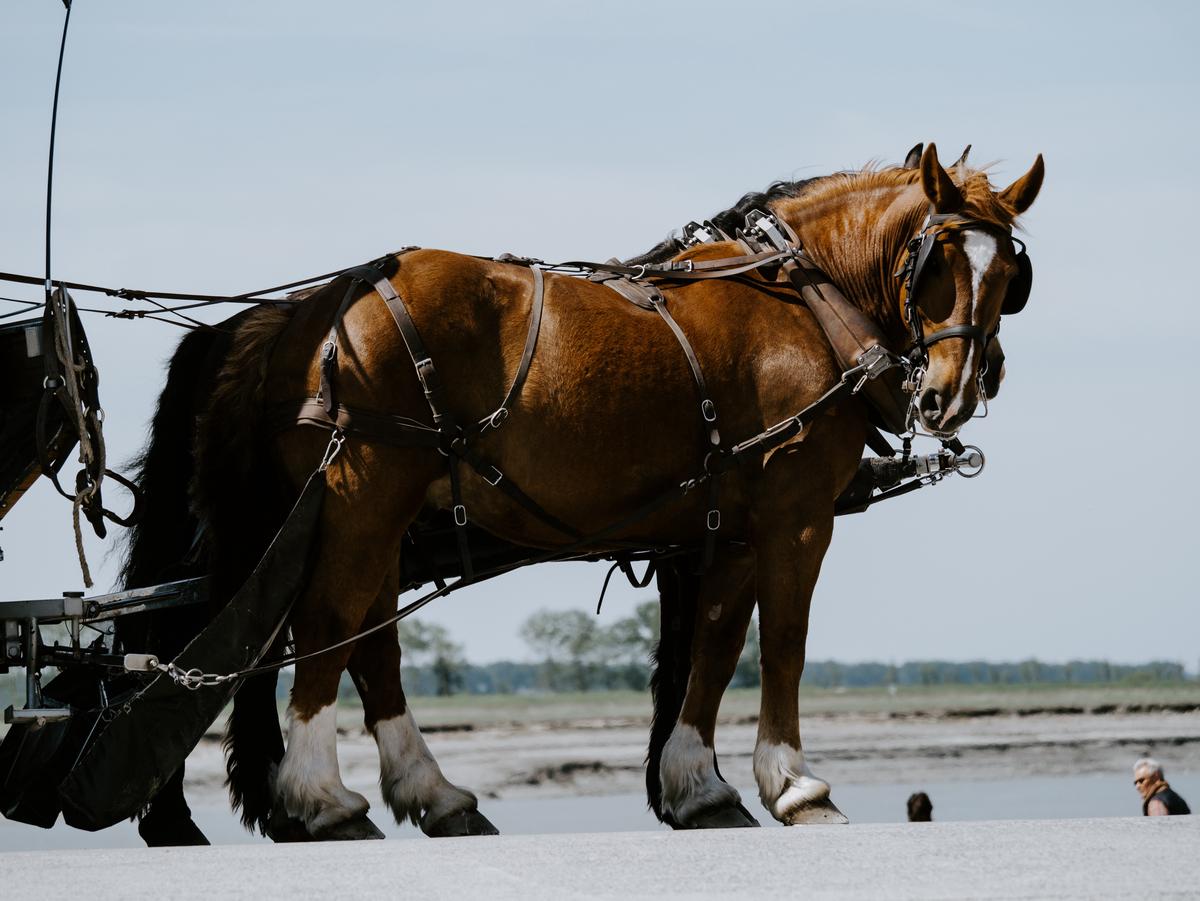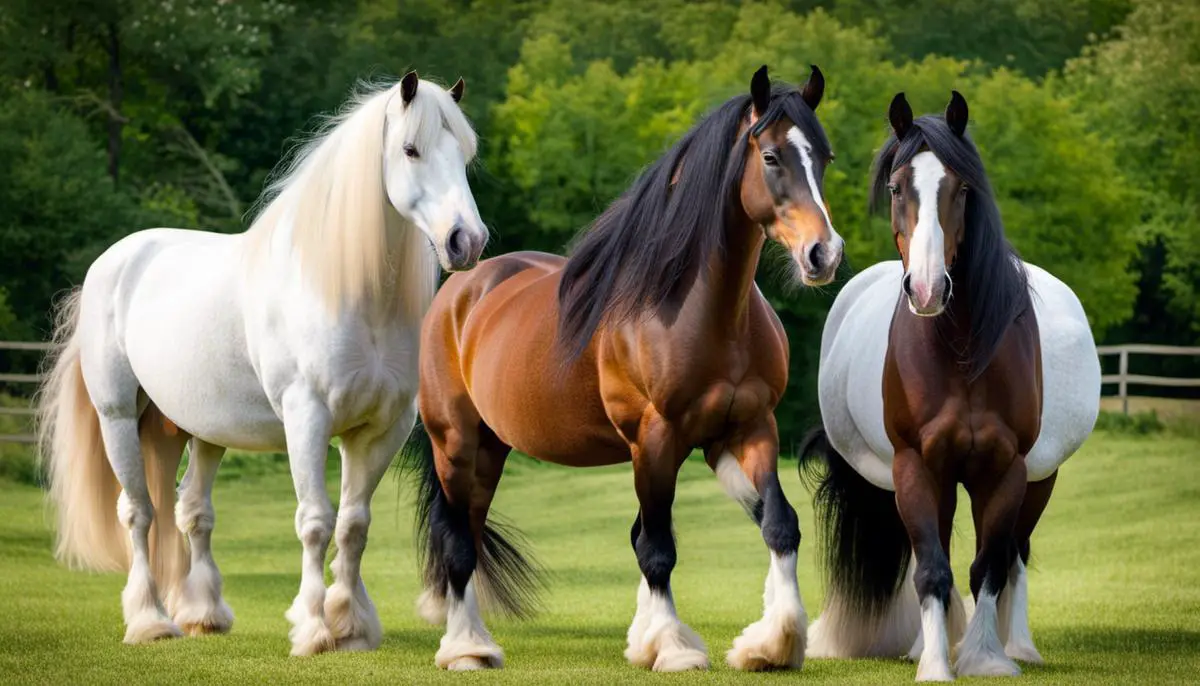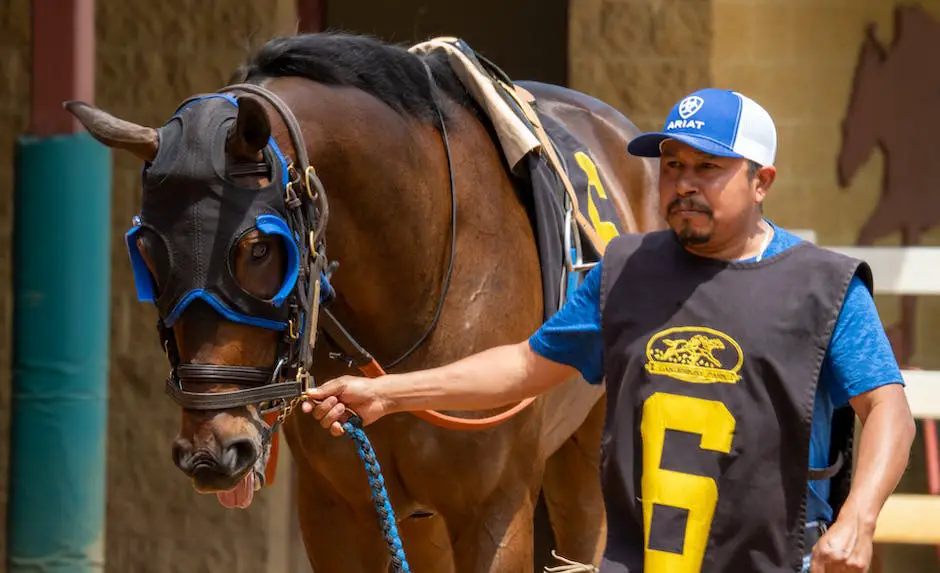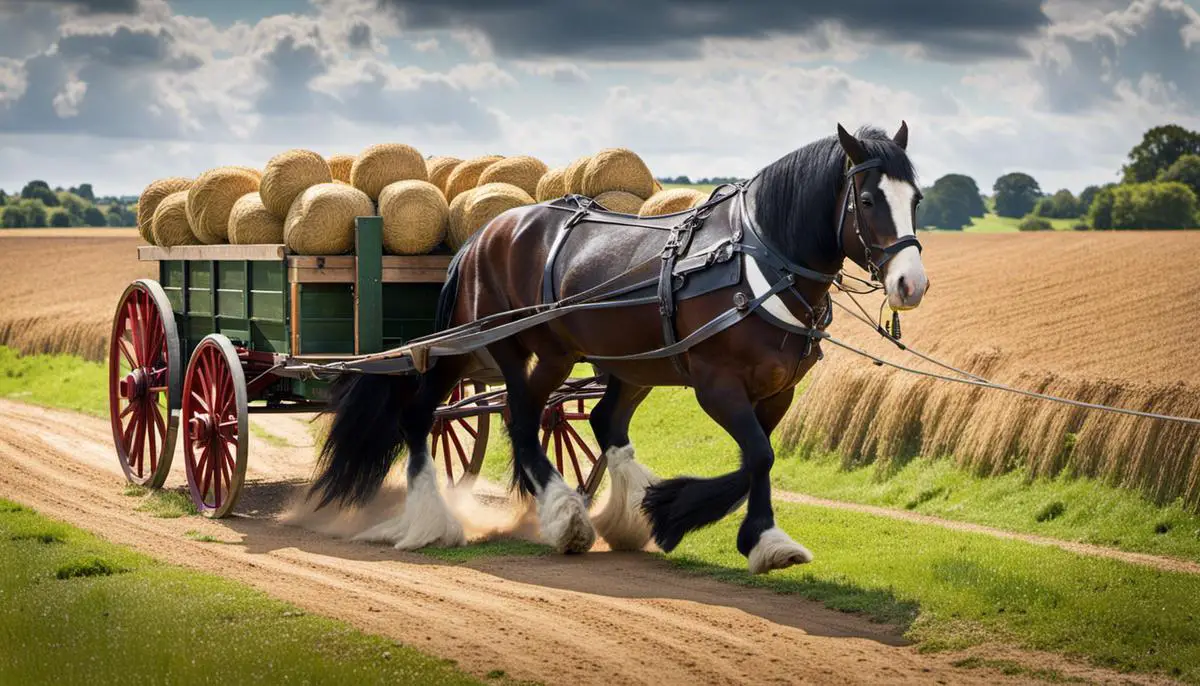The rich tapestry of horses spans diverse breeds, each showcasing a unique amalgamation of characteristics that defines their individual identity. This essay delves into two such noteworthy breeds – the Shire horse, noted for its stature and strength, and the Thoroughbred, famous for its speed and spirit. Ranging from their historical origins to present roles, this exploration will delve into distinct features including physical traits, temperament, and health profiles that set these breeds apart. An understanding of these elements grounds our appreciation of these equine marvels, eliciting a renewed respect for their evolutionary journey and present-day significance.
Table of Contents (Horspedia)
Historical Background and Breed Origin
Historical Background and Breed Origin: Shire Horse
The Shire horse is a breed of draft horse that originated from the United Kingdom. This breed’s history dates back to medieval times, when they were used as war horses carrying heavily armored knights into the battlefield. Following the end of the crusades, these horses were repurposed for farming and hauling heavy goods, as their impressive strength and stature made them perfect for heavy labors.
The historical records relating to the development of the Shire breed are somewhat scattered and inconsistent. Some evidence suggests that the Shire descended from the English Great Horse, and later interbred with the Dutch Friesian. In the mid-19th century, the breed was officially recognized and standardized, and the Shire Horse Society was formed in 1878 in England to formalize breeding efforts for these majestic draft horses.
The Shire horse breed has experienced fluctuations in its popularity and necessity over time. Post World War I, the use of mechanization in farming led to a decline in demand for these heavy draft horses. However, they’ve seen resurgence in recent years for their role in advertisements, parades, and other displays where their sheer size and beauty can be appreciated.
Historical Background and Breed Origin: Thoroughbred
The Thoroughbred is a breed of horse developed in England for racing and riding in the 17th and 18th centuries. They are well-known for their speed, endurance, and spirit, making them ideal for a variety of equestrian sports beyond racing, such as show jumping, polo, and fox hunting.
The breeding and development of the Thoroughbred is well-documented and can be traced back to three foundation sires: the Byerley Turk, the Darley Arabian, and the Godolphin Arabian. These stallions were crossed with English mares to produce the Thoroughbred, a breed that has been meticulously developed and recorded in the stud book since the establishment of The General Stud Book in 1791.
Similar to the Shire horse, the Thoroughbred experienced a decline during the two World Wars but saw a significant increase in population post-war due to their importance in the racing industry. Today, Thoroughbreds are found around the world and continue to be bred primarily for racing yet are also highly valued in several different equestrian pursuits.
Both Shire horses and Thoroughbreds stem from the same geographical origins, but each breed has evolved distinct characteristics, reflecting different facets of their unique equine heritage. The strength and power of the Shire makes it ideal for robust physical tasks, underscoring its historical role in agriculture. On the other hand, the speed and agility of the Thoroughbred exemplify the excitement of racing and equestrian sports. Each breed has a unique and fascinating history and a special place in the horse world.

Photo by mattseymour on Unsplash
Physical Characteristics
Shire Horse: A Display of Strength and Size
Famous for being one of the largest and most formidable breeds, the Shire horse is a sight to behold. These horses typically measure between 17 and 19 hands (approximately 5.7 to 6.3 feet) at the shoulder, although some exceptional specimens have reached up to 22 hands (roughly 7.3 feet). With weights that can tip the scales at a massive 2,600 pounds, these horses demonstrate the correlation between size and strength.
With bodies that are both muscular and heavyset, Shires were bred to perform tough laborious tasks, a clear reflection of their origins as draft animals. They possess long heads, often accentuated by mesmerizing blue eyes, a detail that enhances their majestic appearance. A notable characteristic of these horses are their ‘feathered’ legs, marked by distinctive long hairs around their ankles that thin out towards the hooves.
Shire horses exhibit a range of colorings, with black, gray, bay and a variant of brown known as chestnut being most common. Many Shires also feature attractive white markings on their faces and legs.
Thoroughbred: Sleek and Speedy
Contrastingly, Thoroughbreds, the breed famously associated with horse racing, are markedly different in physical traits from the Shire horse. Built for speed and agility, Thoroughbreds stand at a height ranging from 15 to 17 hands (5 to 5.7 feet), making them smaller than Shires.
Thoroughbreds have a leaner body structure, with long, slender legs and a deep chest – a build that facilitates high-speed gallops. They typically weigh between 1,000 to 1,300 pounds, about half of a large Shire’s weight.
The Thoroughbred’s head is elegantly chiseled and adorned with wide-set, alert eyes. Despite their powerful build, they possess an overall refined and delicate appearance, unlike the robust Shire.
Thoroughbreds come in a larger variety of coat colors – bay, black, dark bay/brown, chestnut, gray, or roan. While white markings are allowed on a Thoroughbred, they cannot be predominant or above the knees.
Comparing Shire and Thoroughbred Horses: Differences in Size, Build, and Color
Both the sturdy Shire and the swift Thoroughbred horses possess their own unique form of majesty. The Shire’s impressive build is a display of power and endurance and stands as a contrast to the refined and agile Thoroughbred, known for its speed and racing prowess.
Although both breeds come in a variety of colors, including black, bay, chestnut, and gray, distinctions can be found. For example, Shire horses often have blue eyes and pronounced feathering on their legs, which is not a common trait among Thoroughbred horses. In terms of color variations, the Thoroughbred has a more robust range, featuring the roan variant absent in Shires.
Examining these two horse breeds highlights their unique characteristics and specific utilizations. While the Shire stands as a testament to raw power and endurance, the Thoroughbred exemplifies light-footed speed and agility.

Temperament and Behavior
Characteristics of the Shire Horse: Unruffled yet Strong
Known as one of the largest horse breeds, Shire Horses are famous for their serene and placid personality. This makes them particularly suited to tasks requiring extreme patience and endurance. They are often engaged in a range of roles, from agricultural work to police operations, and are also used in therapeutic riding due to their calm and dependable nature.
Shire horses, while individually unique, share a common trait of being sociable, gentle, and highly trainable. They are generally considered less temperamental compared to certain other breeds, including the Thoroughbred. Their intelligence makes them quick learners. Overall, they show a pleasing eagerness to cooperate during their training sessions.
Despite their composed nature, their significant size makes it imperative for their handlers or riders to have sufficient confidence and experience. Training a Shire may involve certain specific simulations or exercises due to their historic role as workhorses, including activities related to harness, driving, and draft work.
Thoroughbred: The Spirited Athlete
Thoroughbreds, on the other hand, are lively, high-spirited, and known for their exceptional speed and agility. Bred for racing, these horses are often considered hot-blooded, meaning they are more energetic, fiery and spirited in nature. They are frequently employed in competitive sports such as eventing, show jumping, and of course, horse racing.
Thoroughbreds are known for their sensitivity and responsiveness, which can be a double-edged sword: while it can make well-trained Thoroughbreds highly attuned to their handlers’ instructions, it may also cause them to be more susceptible to stress or nervousness. Some Thoroughbreds, especially those retired from racing, may require careful, patient retraining to adapt to a more relaxed, non-racing lifestyle.
The Thoroughbred’s high energy and active temperament makes them less suitable for novices or those looking for a leisure horse. Their training is often vigorous and specialized, focusing more on building speed, agility, and endurance for racing or other equestrian sports.
Comparing Shire horses and Thoroughbreds, it becomes apparent that these breeds have their distinct capabilities and characteristics. The larger and more tranquil Shire proves its strength through serene power, contrasting with the swift and spirited energy of the Thoroughbred. An understanding of these breeds reveals their suitability to varying fields and tasks, alongside the necessity for a discerning and experienced handler, particularly in the case of the energetic Thoroughbreds.

Health and Lifespan
Comparing Health and Lifespan of Shire Horses and Thoroughbreds
Shires, known for their impressive stature and weight compared to other breeds, usually live between 25-30 years. However, their great size makes them more prone to health issues such as laminitis, a condition that affects the feet, and colic. To avoid these issues and ensure a wholesome life span, Shire horses benefit from regular exercise, a comprehensive diet, and routine veterinary check-ups.
Thoroughbreds, renowned for their speed in racetracks, often have a slightly lesser lifespan between 20-25 years. Racing breeds like Thoroughbreds are predisposed to specific health issues including leg injuries, gastric ulcer syndrome, and the degenerative disease, osteochondrosis, owing to their specialized breeding lines. Close monitoring of their dietary intake, coupled with a consistent exercise regimen and regular veterinary checkups are essential to manage their health.
Despite the differences, one common care requirement for both Shire horses and Thoroughbreds is regular hoof maintenance. Regular visits from a farrier for hoof trimming and shoeing is essential for both breeds, helping to prevent the onset of conditions like hoof cracks or lameness.
Preventative Care Measures for Shire Horses and Thoroughbreds
When considering preventative care, it can be helpful to remember that both Shire horses and Thoroughbreds will benefit from regular vaccinations and deworming. These measures are essential for protecting the horses from various diseases and parasites. It’s also crucial to monitor their teeth; regular dental care prevents eating difficulties, weight loss, and colic.
Another important aspect of preventative care for these breeds is proper diet and nutrition. Shire horses, known for their draft work, typically require a diet high in calories. In contrast, Thoroughbreds, which are often leaner and more athletic, will benefit from a nutrient-dense feeding regimen curated to support their high energy expenditure.
Lastly, both breeds will benefit from a living environment that provides ample room for exercise. Regular movement helps maintain good cardiovascular health and assists in preventing obesity and joint diseases.
A Closer Examination
Both Shire horses and Thoroughbreds are distinct breeds with different physical characteristics, uses, and health considerations. Whether one owns these horses for work, competition, or simple companionship, it is essential to understand their unique needs and potential issues. Regular veterinary check-ups, balanced nutrition, and suitable living conditions can help mitigate most breed-specific issues, enhancing the health and longevity of these horses.

Uses Today
The Majestic Shire Horse: A Jewel in the Crown of the Working and Show Breeds
Shire horses, one of the most majestic and robust horse breeds, originated in England and were initially employed for heavy-duty farming. They are famous for their great strength, calm temperament, and versatile capabilities that extend from forestry to promotional activities in the modern era.
Typically weighing more than 2200 pounds and standing at least 17 hands tall, Shire horses exhibit a commanding presence. Combined with their serene demeanor, they are perfect for tasks requiring immense physical strength and patience. Additionally, the impressive stance and feathered hooves of a Shire horse make them captivating in parades and performances, augmenting their workhorse status with showhorse appeal.
Shire horses truly come alive in the show ring, often primped with intricate braids and adorned with colorful ribbons to highlight their beauty. They participate in various events, from showjumping and dressage to in-hand showing, exemplifying their versatility. Their calm demeanor wins accolades from judges, and their elegance and majesty command audience attention.
Thoroughbred: Elite Racing and Sport Horses
Unlike the Shires, Thoroughbreds are bred for their speed and agility. These horses are famous globally as premier racing horses, with athletic bodies, long legs, and high stamina. These characteristics have made them unrivaled in horse racing sports and have continued to increase their demand in other equestrian events.
Thoroughbreds can gallop at over 40 miles per hour, making them one of the fastest horse breeds. This speed and endurance give them an edge on the racetrack, where they are regarded as elite athletes. The Thoroughbred’s racing lineage goes as far back as the 17th century, and their pedigree is carefully maintained to this day.
However, Thoroughbreds are not just racers. Their athleticism and versatility extend to various equestrian sports such as eventing, show jumping, and dressage. They are prized for their quick response, agility, and courage, traits that are vital in these demanding sports. Outside the sporting world, Thoroughbreds also excel as riding and pleasure horses due to their sensitivity and willingness to please.
In conclusion, the shire horses and thoroughbreds fulfill distinct roles due to their innate traits and skills. The former, known for their strength and power, remain indispensable working animals and show horses, while the latter, famous for their speed and agility, rule the racetrack and perform valiantly in various equestrian sports.

The vibrant world of horses offers endless fascination, ably represented by the Shire horse and Thoroughbred breeds. Their distinctive characteristics, alignment within selective roles, and unique temperaments continue to draw admiration from horse enthusiasts to novices alike. Their close association with humans, rooted in historical times, paints an intriguing narrative highlighting the co-evolution of our societies. With thoughtful care, these breeds can live healthy lives, enriching our own with their presence. As we come to understand their strengths and potential challenges, we cement our relationship with these noble beasts, honoring their historical significance and sustaining their legacy for generations to come.
